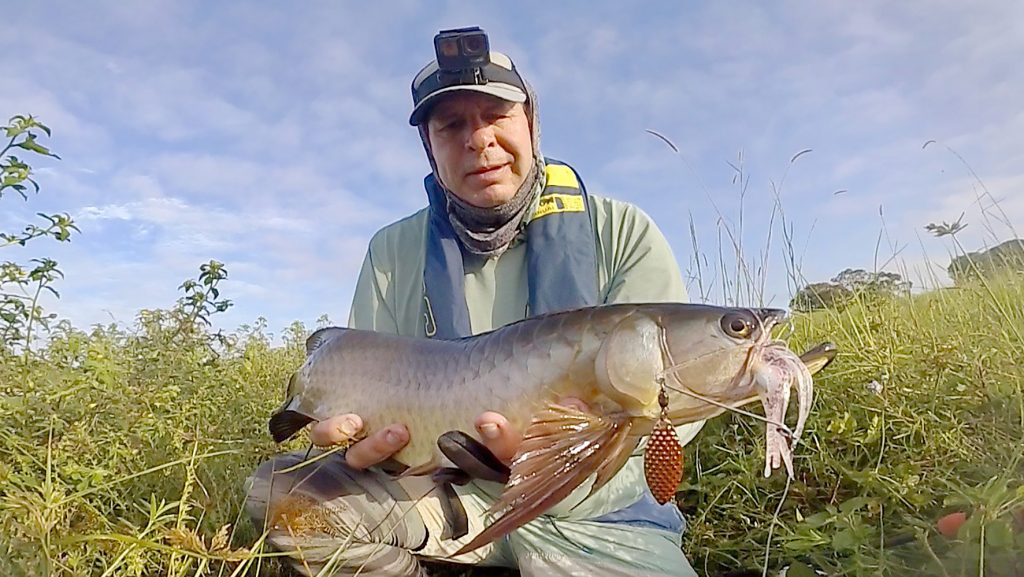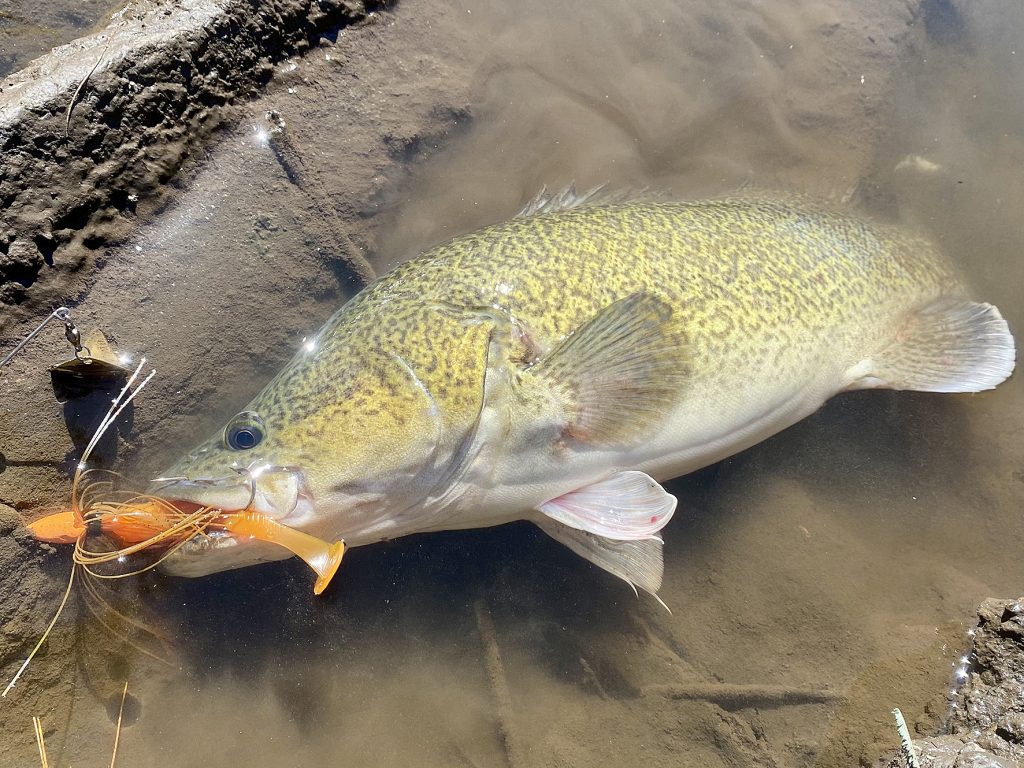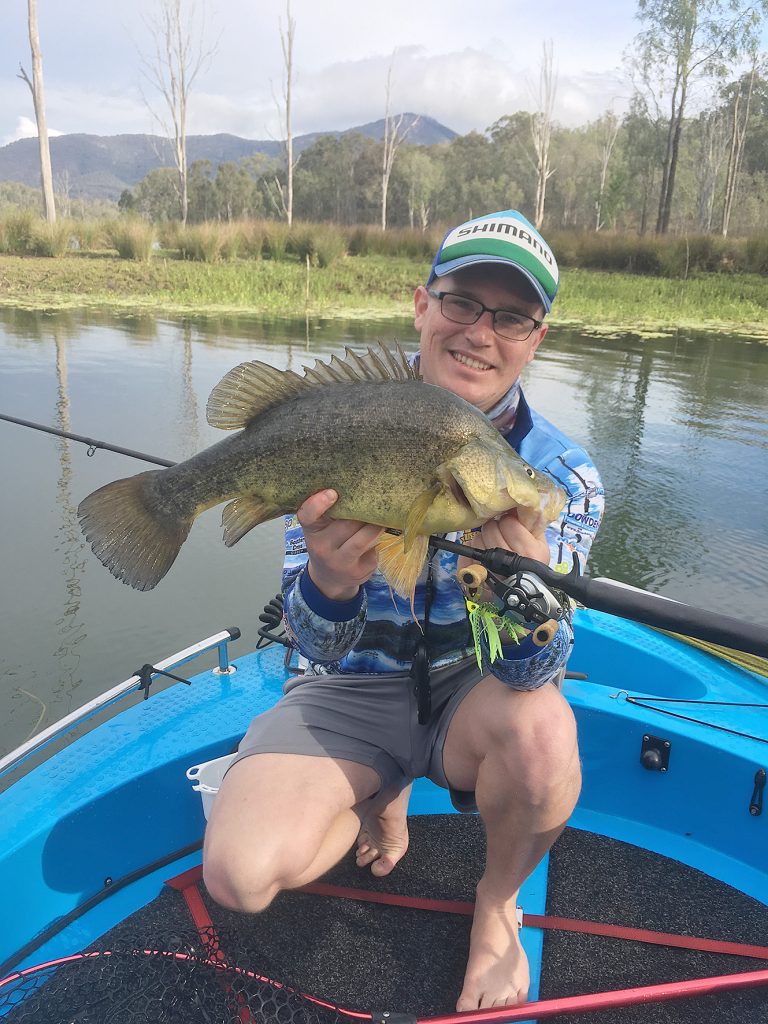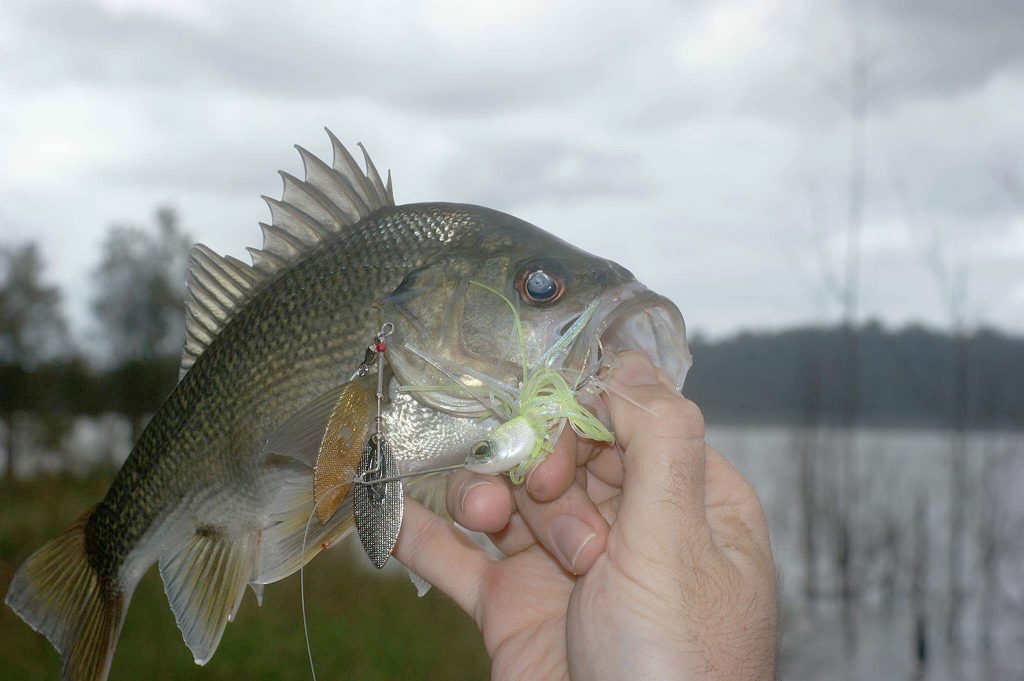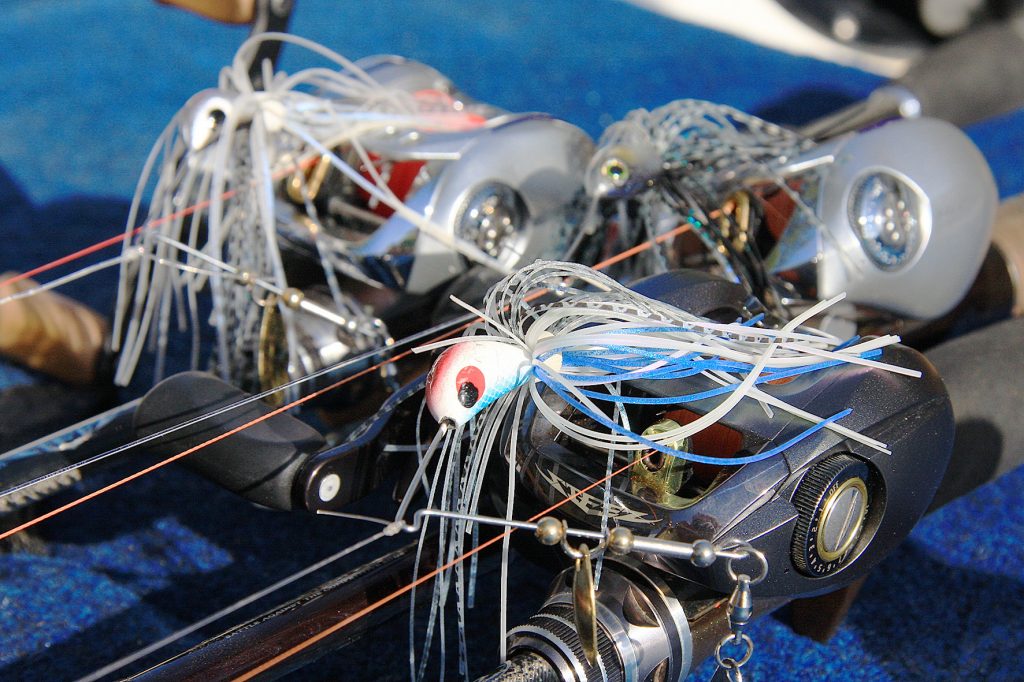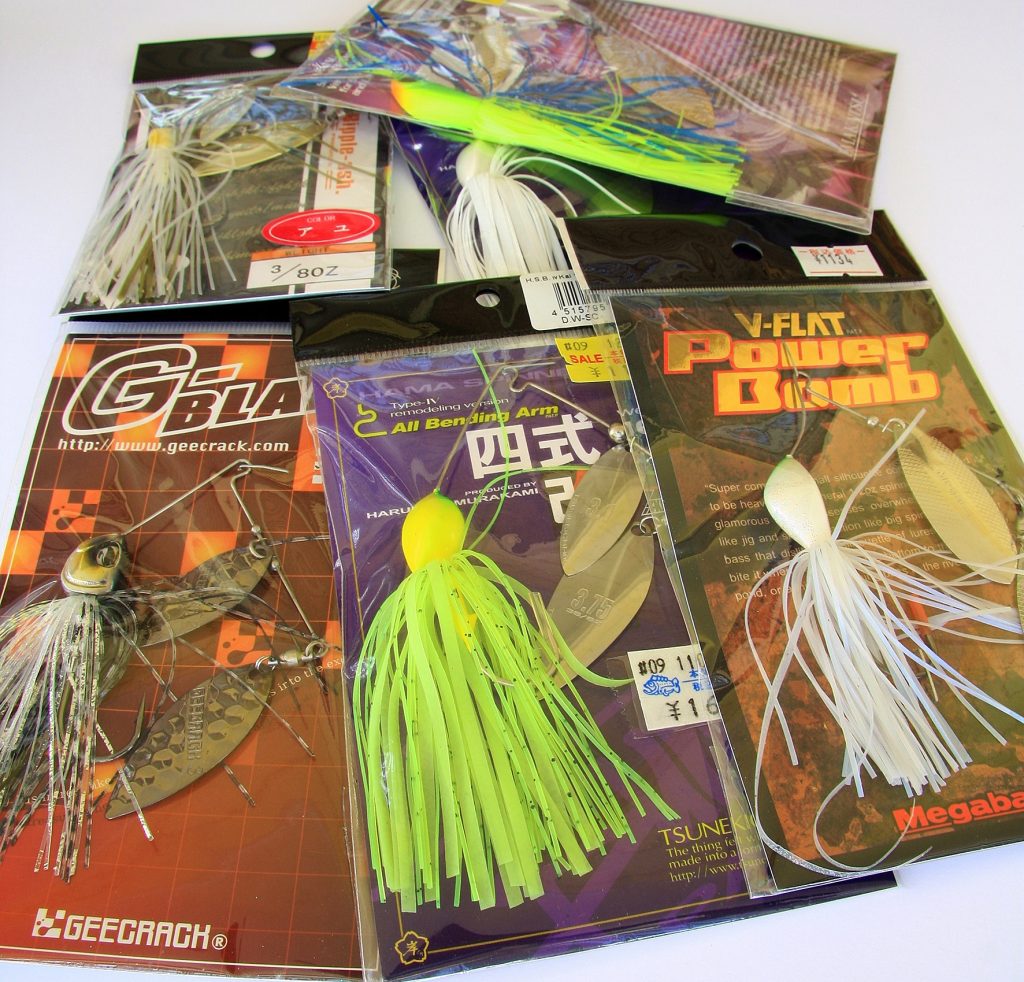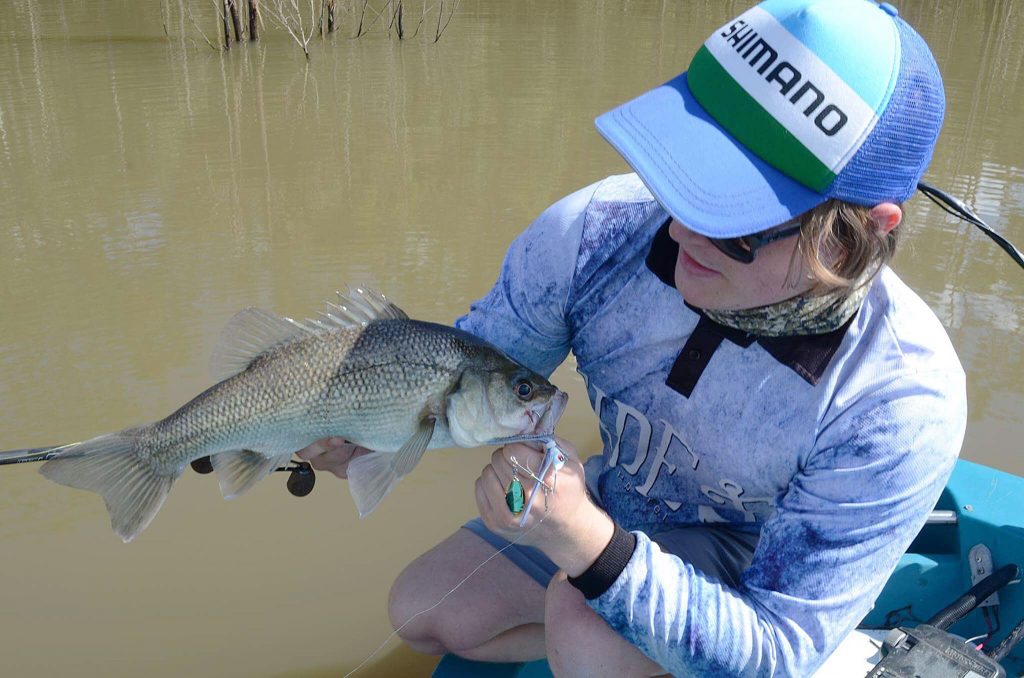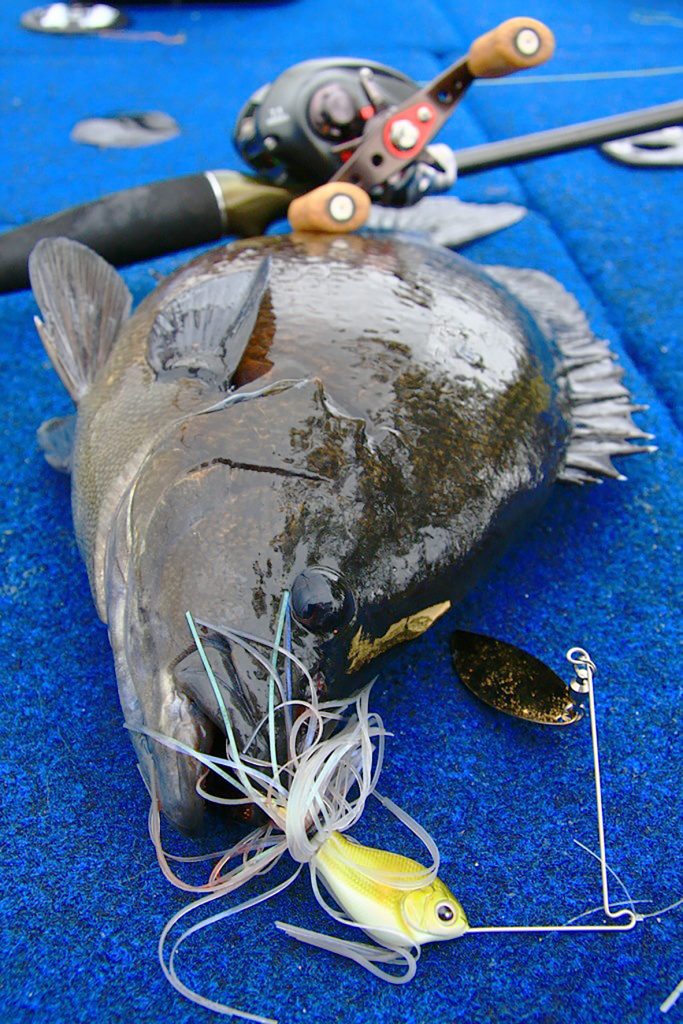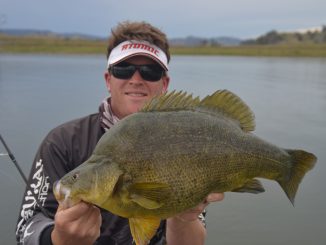
• by Elliot Fooks (first published April 2021)
Spinnerbaits are nothing new in the fishing world, and Aussie anglers have been including these strange contraptions to their arsenal for over 25 years. Spinnerbaits have changed quite a bit from the days when they bore a closer resemblance to a coat hanger with Christmas decorations than a fishing lure. Nowadays, these compact and extremely versatile lures are a staple for many fishers, and while the lures have changed, a lot of the techniques and theories are the same.
SPINNERBAITS AND FRIENDS
Traditionally, a spinnerbait consists of a weighted head with a single hook, with a body made of a skirted material or a soft plastic trailer, sometimes both. Extending from the weighted head is a wire arm with a kink, where the line is usually tied. On this arm is one of more blades that catch the water when pulled along and spin, sending out vibrations and flash though the water. The most common blades are Colorado blades, which are rounded, and Willow blades, which look a bit like a willow leaf.
Sure, they don’t really resemble anything in the animal kingdom, but no one can argue with the results! Variations of this lure have become available over the years, such as beetle spins, jig spins, chatterbaits and buzzbaits, which are all often used in similar situations. In this article though, we’ll focus on the traditional skirted spinnerbait with a fixed wire arm.
TACKLE
Given that spinnerbaits can be used for a wide range of species, from bass in small streams to impoundment Murray cod over 40kg in large lakes, the preferred tackle for spinnerbait users varies widely. There are certain principles that apply across the board, however.
Unless using tiny 1/8oz models or lighter, baitcast tackle is highly recommended. An appropriately weighted baitcaster will give you the authority to throw heavy lures like spinnerbaits, and the control you can achieve with a baitcaster is very useful when fishing the snaggy terrain where these lures shine.
Baitcast tackle also has the advantage of maintaining direct contact with the lure at all times, meaning you can feel everything through the rod. Being able to feel every vibration, contact with snags and bite will make your spinnerbait experience much more enjoyable, and you’ll likely land more fish.
SPINNERBAIT SPECIES
There are a huge range of species around the world that will respond to these lures, and knowing the right conditions to throw them for each species is good knowledge to have. The main Australian species that are regularly taken on spinnerbaits are bass, yellowbelly, Murray cod, saratoga and sooty grunter. There are other species that will take spinnerbaits, but we’ll focus on these five.
Bass
This is perhaps the most well-known spinnerbait taker, and the species with which all the original hype started back in the ‘90s. In the early days of ABT, tournament anglers would cast white Kokoda spinnerbaits at the lake’s edges and claim dozens of bass in a single session. While impoundment bass have since become a bit more educated, so have anglers, and spinnerbaits are still as deadly on this species as they ever were.
Spinnerbaits can be used all year successfully for bass (with the exception of the closed season in rivers), but the technique changes with the seasons.
In spring and summer bass will be fizzed up, with their metabolism picking up after winter. In rivers and impoundments, they will be relating to structures such as timber, weed or rock and more than willing to leave their cover to chase anything that looks tasty. Heavy 1/4-3/8oz models in bright colours such as chartreuse and white are perfect for these aggressive fish.
Spinnerbaits are fantastic when worked through cover, as their wire arm acts like a weed guard, particularly if you maintain a steady wind as you feel it bump over the structure. This is basically knocking on the fish’s door, and when it all becomes too much they should dash out and snaffle the spinnerbait.
As it cools off a bit, bass will slow down. In impoundments where they can be targeted through the winter, they’ll either be sitting fairly still in shallow water trying to warm up with the sun, or if there are schooling forage species such as bony bream in the dam they may be grouped up in open water eating these small silver fish.
Up in the shallows, small, lightly weighted spinnerbaits that can be worked slowly will get the best results. Pausing the retrieve will see them falling slowly, with the blades helicoptering and sending out flash and vibration to fish from afar. The ‘noisy’ colours preferred in spring and summer might be a little much for winter bass in the shallows, with more natural colours being more suitable.
If fishing around a bony bream school, it makes sense to try to replicate these fish. Heavy 3/8-1/2oz models in white and grey that will get down to 20-30 feet fairly quickly can be deadly when worked slowly through a school. It doesn’t always work, but if the fish are really keyed into the bony bream it should at least draw a bit of interest.
Yellowbelly
Yellowbelly are another species that respond well to spinnerbait techniques. Being a foraging species that prefers the comfort of heavy cover, they lend themselves to these weird creations.
The first thing to remember with yellas is that they are very seasonal with their feeding habits. They are at their most active in spring and summer, becoming more difficult in autumn, and becoming difficult to almost uncatchable in winter.
In the spring when they are seeking warmth in the sunlit shallows, whether in a lake or river, they are very responsive to spinnerbaits. In some cases, fish can be seen sitting motionless in the skinny water as they catch the first rays of the morning. It’s simple, if you see one sitting there, throw a spinnerbait in front of it and see what happens. Sometimes they require the more subtle touch of a soft plastic or fly, but spinnerbaits are a good allrounder in spring. Weights of 1/8-1/4oz work well in the shallows for this small-mouthed forager.
As it warms up over summer, the yellas will sit deeper, often forming schools in lakes, and huddling closer together in the thickest of snags in the rivers. Spinnerbaits are still a great all round bait, however heavier models such as 1/4-1/2oz models may be needed to reach these depths comfortably. Feeling the structure through your rod as the spinnerbait bounces over pieces of cover is a great way to ‘map out’ the depths as you fish your way around. Repeated casts to likely areas are a good idea when chasing yellas, as they may take a bit of persuasion to bite when it’s hot.
Murray cod
Spinnerbaits are a lure virtually made for this incredibly aggressive species. I can’t begin to imagine how many Murray cod have been taken on spinnerbaits and lures like them.
Going cod fishing without any of these lures is like going to a St Patrick’s Day event without a case of Guinness. All jokes aside, you’d be mad not to have a range of larger spinnerbaits for your cod missions, and anything from 1/4oz and right up to 2oz (and possibly beyond) isn’t too silly to be throwing.
At any time of the year, a spinnerbait is a good way to cover lots of water searching for this territorial species, and having the ability to work it right up hard against structure is a huge benefit.
Whether it’s rocks, timber, grass or artificial structure, spinnerbaits can be fished to their full effect through it, and getting close to cod is the key to catching them. As mentioned above, mapping out the structure beneath with the spinnerbait is important; probably more important than with yellowbelly. If a bite is registered, try to visualise what’s down there and make repeated casts to the area, adjusting your retrieve to suit the terrain. You might, for instance, speed the retrieve up when a large structure juts out from the bottom, or possibly slow down if there’s a hole, and maybe even add a few twitches when you get close to the strike zone!
Spinnerbaits also make great trolling lures for cod, and if you can find a speed where the lures is occasionally bumping over structure as you troll along, you’re in with a good chance. There’s also no pesky tuning required with these lures; they’re good to go out of the packet!
Saratoga
Once again, spinnerbaits are almost a perfect lure for these prehistoric leapers. Having the ability to cover water quickly and call in fish from afar is key when chasing saratoga, and spinnerbaits do this better than other lures.
Toga tend to spend most of their time on or near the surface, whether in lakes or rivers, and are virtually always on the lookout for food. If something falls near them, they will often strike it without actually stopping to look at what it is.
Spinnerbaits don’t have to be massive for toga, and a 1/4oz (give or take a few grams) should have you pretty much covered. Big willow blades and bright colours like chartreuse and white are fairly standard, and should turn the head of most hungry toga.
When toga can be seen searching for food on the surface, a cast off to the side (so as not to spook them) should be enough to fool them. If you’re just blind casting, moving quickly and working your spinnerbaits relatively quickly within 1-2m of the surface is a good way to go. If you spot a toga following, it can pay to stop for a second and let it fall slowly in the water column. Remember, spinnerbaits keep ‘working’ even as they sink.
Just like with Murray cod fishing, you’d be mad to go looking for saratoga without a handful of spinnerbaits.
Sooty grunter
This is a fish that’s often forgotten about, but is one of my favourites. Their willingness to chase things well out from their snaggy homes and tendency to hang out in groups endears them to many anglers. And yes, they absolutely love spinnerbaits.
In rivers of lakes, sooties will often hole up together, and if something remotely edible should enter their domain, a squabble will break out about who gets to eat it. Because of this, they will often hit lures at speed and take anglers by surprise.
Sooties everywhere like to chase their prey, and given that spinnerbaits work well even at higher speeds, they’re a great choice for these northern brutes.
Picking a model to use isn’t rocket science, with anything between 1/8-1/2oz suitable, depending on where you’re fishing. Colours also aren’t anything to stress over either, just make sure your skirts and hooks aren’t too big, as sooties only have a small mouth.
In lakes such as Eungella and Koombooloomba, big sooties will sometimes hang below trees with birds in them, waiting to snaffle any white droppings that come out of the birds. A white spinnerbait crashing down under one of these trees often gets hit seconds after landing… There’s nothing delicate about sooty fishing!
LITTLE TRICKS
One of the best things about spinnerbaits is how customisable they are. Skirts and blades can be swapped out and changed, and stinger hooks can be added to increase hook-up potential.
If you notice you’re getting short strikes on a particular spinnerbait, you can snip a few centimetres off the skirt to reduce the profile of the bait… but you might prefer to change to a smaller spinnerbait if you don’t want to snip something you can’t fix!
IN A SPIN
Understanding just how versatile these lures are and the different ways you can use them in different situations will help you get the most out of them. I believe anglers have only just scratched the surface though. The species mentioned above readily take spinnerbaits, but there are more freshwater and saltwater predators that won’t turn down a spinnerbait under the right conditions. Don’t let the status quo dictate how you can use these lures, and which species you can use them for, get out and start experimenting!

